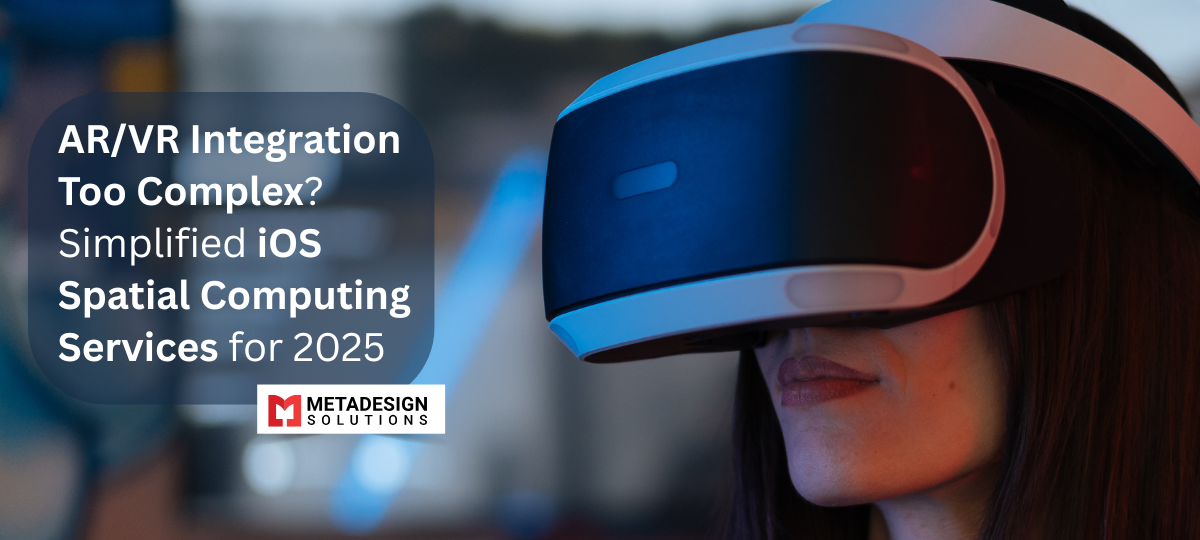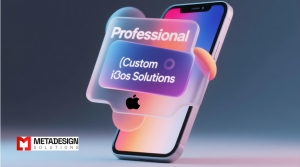Introduction: The AR/VR Boom and the Complexity Barrier
As we enter 2025, augmented reality (AR) development and virtual reality (VR) development are no longer niche technologies—they’re integral to how we interact with data, environments, and digital content. From training simulations to immersive shopping, enterprises are rushing to build immersive apps. But there’s a catch: integrating AR/VR into iOS apps remains deeply complex.
Thankfully, Apple’s latest spatial computing stack—including VisionOS, ARKit 6, and RealityKit 3—has made it significantly easier to build robust AR/VR applications. In this blog, we explore how simplified iOS spatial computing services are streamlining AR/VR integration for 2025 and beyond.
What Is iOS Spatial Computing?
iOS Spatial Computing refers to Apple’s suite of tools and frameworks that enable devices to understand and interact with the physical world in 3D. With the release of Apple Vision Pro and VisionOS, developers can now create spatially aware applications that combine:
- Depth sensing and room mapping
- Gesture-based control and eye tracking
- Real-world object recognition
- Mixed reality overlays
These services empower businesses to deliver next-gen user experiences through cutting-edge AR/VR solutions.
Key Components:
- ARKit 6 – For motion tracking, light estimation, and spatial anchors
- RealityKit 3 – For real-time rendering, physics, and 3D object interaction
- VisionOS SDK – A new SDK optimized for Apple Vision Pro’s spatial environment
Why AR/VR Integration Feels Complex Today
1. Fragmented Tooling
Different SDKs (ARKit, SceneKit, Metal, RealityKit) don’t always play nicely together.
2. Hardware Constraints
Many AR apps are designed without testing on headsets like Apple Vision Pro.
3. Poor Spatial UX Design
Designing UIs for 3D environments requires a different mindset and skill set compared to traditional 2D mobile apps.
4. Lack of Real-Time Rendering Skills
Developers often lack experience in rendering 3D scenes at scale with performance constraints.
5. Difficulty with Device Calibration and Anchoring
Many apps fail due to inconsistent spatial anchors and environmental mapping.
iOS Spatial Computing Services That Simplify AR/VR in 2025
1. Spatial UI/UX Design for VisionOS
At MetaDesign Solutions, we help design spatial interfaces optimized for Apple Vision Pro, focusing on:
- Eye gaze navigation
- Gesture control zones
- Spatial menu hierarchies
2. ARKit Integration Services
We streamline the use of ARKit 6 with best practices for:
- Scene reconstruction
- Image and object detection
- Body tracking and motion capture
3. RealityKit 3D Scene Rendering
Our developers create photorealistic scenes using RealityKit:
- Real-time shadows and occlusion
- Physics-based animations
- Environmental audio spatialization
4. Spatial Anchoring and Environment Mapping
We ensure accurate 3D positioning using:
- World tracking
- Plane detection
- Persistent anchors with cloud syncing
5. Testing and Optimization for Apple Vision Pro
- Device simulation using VisionOS SDK
- Performance benchmarking for headset apps
- User testing in XR labs
AR/VR Integration Too Complex? Simplified iOS AR/VR & Spatial Computing Services for 2025
Unlock the full potential of AR/VR with our streamlined iOS Spatial Computing Services—read the blog to simplify your journey into immersive tech.
Key Use Cases Driving AR/VR Adoption
1. Retail and E-Commerce
- Virtual try-on apps
- Augmented in-store navigation
- Spatial product demos
2. Training and Education
- Anatomy learning through mixed reality
- Real-world scenario simulation
- Spatial quizzing and content overlays
3. Healthcare and Therapy
- Exposure therapy via VR
- Surgery planning using AR overlays
- Spatial diagnostics tools
4. Industrial and Field Services
- On-site AR instructions
- Digital twin integration
- Real-time sensor overlays
5. Entertainment and Gaming
- Immersive multiplayer XR games
- AR storytelling experiences
- VR concert and sports broadcasting
Technical Architecture: Building an iOS Spatial App in 2025
Step-by-Step Stack:
- VisionOS Base Layer – Provides spatial canvas and device input mapping
- RealityKit Engine – Handles rendering, animations, physics
- ARKit Services – Enables tracking, anchoring, body/face detection
- SwiftUI + UIKit Integration – Used for fallback and hybrid UIs
- Custom APIs and WebSockets – Real-time multiplayer or sensor integration
Optional Add-ons:
- CoreML for on-device AI processing
- Metal for advanced shader support
- Firebase or AWS for backend sync and analytics
Challenges and Our Solutions
| Challenge | Our Solution |
| Inconsistent spatial anchors | Cloud-synced persistent anchors |
| Frame rate drops on iPhone | Scene optimization and LOD models |
| UX doesn’t adapt to headset | VisionOS-specific UI components |
| 3D models too heavy | GLTF compression + batching |
| No team experienced in ARKit | Dedicated iOS spatial team at MetaDesign Solutions |
Why Choose MetaDesign Solutions?
MetaDesign Solutions offers:- 15+ years in iOS development
- Certified Apple developers and AR specialists
- Expertise across ARKit, RealityKit, and VisionOS
- Cross-platform capabilities (Unity, Unreal, WebAR)
- Proven AR/VR case studies across retail, healthcare, and gaming
Future of iOS Spatial Computing
In 2025 and beyond, Apple’s ecosystem is set to lead spatial computing. With Vision Pro, new iPhones, and AR-first design philosophies, developers and enterprises will need:- Adaptive UI frameworks
- Cross-device XR strategies
- Seamless cloud integration
Ready to Build Spatially Smart Apps?
If you’re facing complexity in AR/VR integration, let MetaDesign Solutions simplify it for you. From design to deployment, we deliver scalable iOS spatial experiences that stand out. Explore how Augmented Reality is transforming industries worldwide and see how your business can harness its potential with the right iOS solutions.
Hashtag Related:
#iOSAppDevelopment #iOSAppDevelopmentServices #iOSApplicationDevelopment #HireiOSDevelopers #CustomiOSApps #iPhoneAppDevelopment #iOSDevelopmentCompany #iOSMobileApps #AppDevelopment2025 #MobileAppExperts #SwiftDevelopment #AppleAppDevelopment #iOSUIUXDesign #EnterpriseiOSApps #MetaDesignSolutions #CustomiPhoneAppDevelopment #iOSAppDesign #AppStoreReady #iOSDevTeam #BuildForiOS


